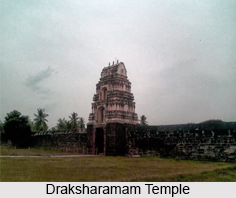 Abode of Lord Bhimeswara and Goddess Manikyamba, the Draksharamam Temple is located in the Krishna district of the Indian state of Andhra Pradesh. The presiding deity at the temple is in the form of a 2.6 m tall crystal "Lingam", known as the "Spatika Lingam".
Abode of Lord Bhimeswara and Goddess Manikyamba, the Draksharamam Temple is located in the Krishna district of the Indian state of Andhra Pradesh. The presiding deity at the temple is in the form of a 2.6 m tall crystal "Lingam", known as the "Spatika Lingam".
Etymology of Draksharamam Temple
The word Draksharamam literally means the "Abode of Daksha Prajapati", who was the father of Goddess Sati and the father-in-law of Lord Shiva. Popularly known as the Dakshina Kasi Kshetram, the Draksharamam Temple is among the 5 most powerful Lord Shiva temples in the country and is called the "Pancharamas" in the state.
Legend of Draksharamam Temple
According to the Skanda Purana, King Daksha once performed a great Yagna with the motive to insult his son-in-law Lord Siva. The king invited everyone except Shiva. Sati, though uninvited, attended the Yagna and was ill-treated. Unable to withstand the insult she immolated in the Yagna. The news of his deceased bride enraged Shiva, so he carried Sati over his shoulder and danced the "Pralaya Tandava" or the dance of destruction. To stop this, Lord Vishnu used his Sudarshan Chakra to cut down Sati"s body into pieces. The places on which the parts of Sati fell are called the Shakti Peethas and Sri Manikyamba of Dakshramam is the one of those places, where the left cheek of Sati fell. Thus, the Dakshramam Temple is known as the Daksha Vatika and later as Dakshramam or Draksharamam.
As per another legend, it is believed that sage Vyasa performed penance here and named the Dakshramam Temple as Dakshina Kasi. Legend has it that the Saptamaha Rishis to fulfil their penance divided the Godavari River into seven different streams at Draskharama. The Bharadhwaja, Viswamitra and Jamadagni streams were known as Antarvahinies, and were believed to have gone underground. There is Sapta Godavari Kundam or a seven river pond near the temple where the devotees bathe.
Architecture of Draksharamam Temple
With a rich history that dates back to the 13th century, the Draksharamam Temple is an ancient and holy pagoda that is also a protected monument, preserved by the Archaeological Survey of India. The inscriptions and epigraphs on the walls of the temple dates back to the 9th and 10th centuries, during the reign of the Chalukyan King Bhima. The inscriptions have provided the historians with a detailed description of the battle between the Chalukyas and the Rahstrakutas. There are over 400 inscriptions, which also described the reigns of the Chola and Kalinga dynasty.
The temple has been built in a typical south Indian architectural style, consisting of two mandapas along the walls. The sanctum sanatorium consists of an intricate door and a pedestal, which was built for the priests to perform rituals. When the Mughal Emperor Aurangzeb invaded the temple, he plundered its premises and took the diamonds encrusted on the walls of the inner sanctum.
Some of the main festivals performed in the temple premises are the Maha Shivaratri, Kalyanam, Devi Navaratrulu, Dhanurmasam, etc. The temple is popular among devotees and attracts tourists from all around.
Visiting Information on Draksharamam Temple
The Samalkot Junction is the nearest railway station at a distance of 39 km from the temple and the Rajamundry Airport is the closest at a distance of about 53 km from the Draksharamam Temple.





















